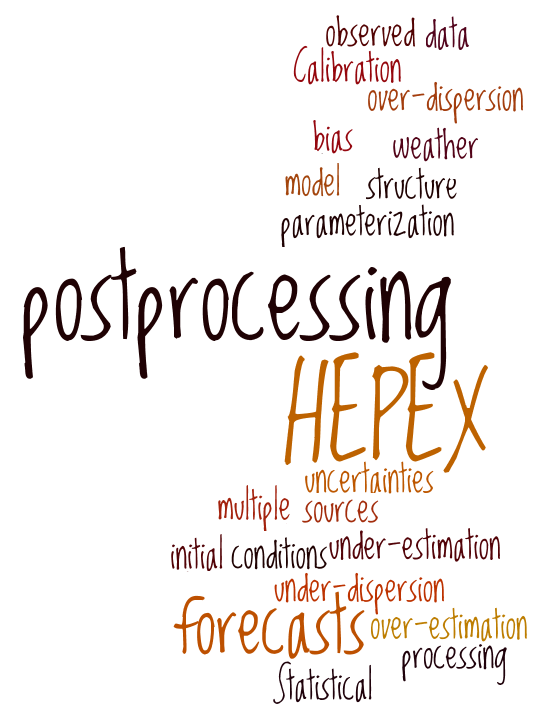HEPEX-SIP Topic: Post-processing (1/3)
Contributed by Jan Verkade, Maria-Helena Ramos and Nathalie Voisin
Before summarizing achievements and challenges for this topic, let’s first discuss what is behind the word ‘post-processing’ (as we understand it!)
 Hydrological ensemble forecasts are characterized by uncertainties originating from multiple sources: observed data, weather forecasts, model parameterization and structure, initial conditions, etc. This may result in forecasts being biased in either mean (under/over estimation) or spread (under/over dispersion), or in both.
Hydrological ensemble forecasts are characterized by uncertainties originating from multiple sources: observed data, weather forecasts, model parameterization and structure, initial conditions, etc. This may result in forecasts being biased in either mean (under/over estimation) or spread (under/over dispersion), or in both.
Statistical processing of model outputs can correct for or reduce some of these biases. In general, it basically comprises procedures that statistically characterize the frequency distribution of past prediction errors and apply this information to correct the new forecasts issued by the forecasting system.
The aim is to provide calibrated probabilistic forecast or confidence intervals in hydrological prediction.
Identification of the error model to be used, calibration against observations and extensive testing over different hydro-climatic conditions are usually required to develop operationally robust techniques.
Putting the focus on hydrological forecasting,
- preprocessing will refer to techniques that are applied to meteorological forecasts used as input to the hydrological model.
- Similarly, postprocessing refers to techniques applied to outputs of the hydrological model.
Postprocessors can be used in combination with preprocessing techniques. In addition, statistical postprocessing techniques can be combined with hydrologic data-assimilation techniques applied for model state variable updating or output error correction.
Forecast postprocessing is also intrinsically related to forecast verification: feedback from verification allows the forecaster to target the main biases to be corrected in postprocessing and to evaluate the performance of different bias correction strategies.
When postprocessing techniques are used to quantify the uncertainty of hydrologic predictions, two cases are identified, often referred to as ‘simulation mode’ and ‘forecast mode’. Their basic difference is on the separation (or not) of the total predictive uncertainty into ‘forcing’ (or input) uncertainty and ‘hydrologic’ (or model) uncertainty.
- In simulation mode, postprocessors are developed to assess errors in the hydrologic modeling and to provide hydrologic simulations with reliable confidence intervals to decision-making. Error models are set up on the basis of past simulations obtained by using observed meteorological forcing as input.
→ The hydrological model is assumed to behave similarly (i.e., error structure will be similar) whether it uses weather observations or forecasts as input (which may not be true if these come from different data sources).
- In forecast mode, postprocessors deal with the overall evaluation of uncertainties in the forecasting system. They need to be combined with calibrated probabilistic weather forecasts or integrated to uncertainty processors of other error sources that play an important role in the total predictive uncertainty. Error models are setup on the basis of hindcasts: hydrological forecasts are obtained using forecast meteorological forcing as input. Methods usually have to handle forecast error dependency relationships across lead times to provide time coherent scenarios of the bias-corrected forecast, which will be subsequently used in a user’s application model (e.g., hydraulics propagation model, water quality model, reservoir model for water resources management, etc.).
→ Here, one assumes that the weather forecast model used during the calibration (i.e., in hindcast) will be the same used in real-time forecasting (which may not be straightforward given the various improvements that are continuously brought to numerical weather prediction models).
Postprocessing is one of HEPEX six major themes
Two HEPEX Special Topics Workshops were held in Delft, The Netherlands, in 2008 and 2011 to promote scientific exchanges and discussions on the topic within the scientific and user community.
Following the initiative proposed on the 2011 workshop, the HEPEX Experiment on the Intercomparison of streamflow post-processors was launched on June 2012, and will pursue in 2013.
Additionally, in the last years, several sessions aligned with the scientific goals of HEPEX have been convened during international conferences, such as the General Assembly of the European Geosciences Union (EGU) and the Fall Meeting of the American Geophysical Union (AGU).
Part 2: Literature review on post-processing (https://hepex.org.au/hepex-sip-topic-post-processing-23/)
Part 3: Challenges and research needs (https://hepex.org.au/hepex-sip-topic-post-processing-33/)
0 comments